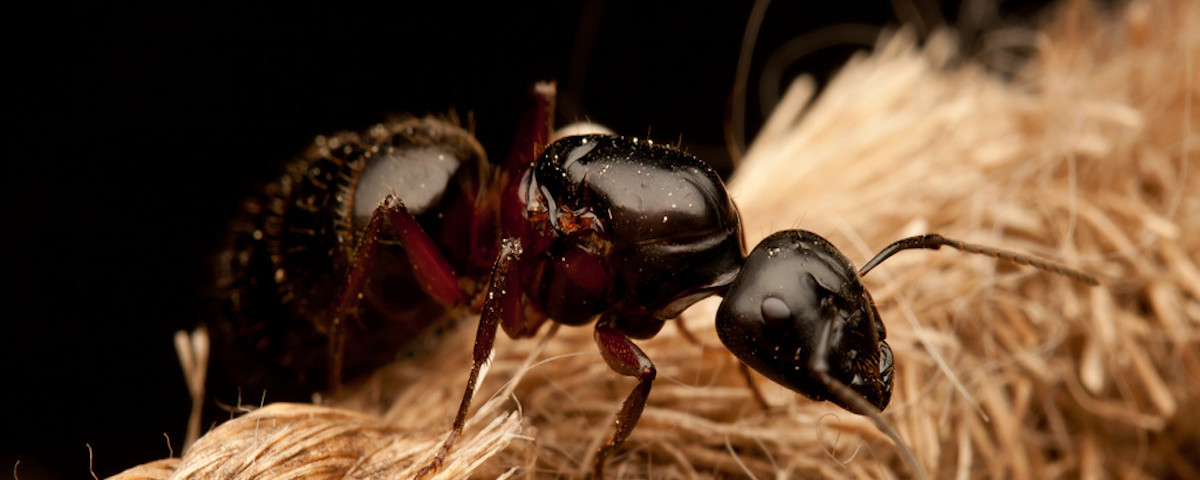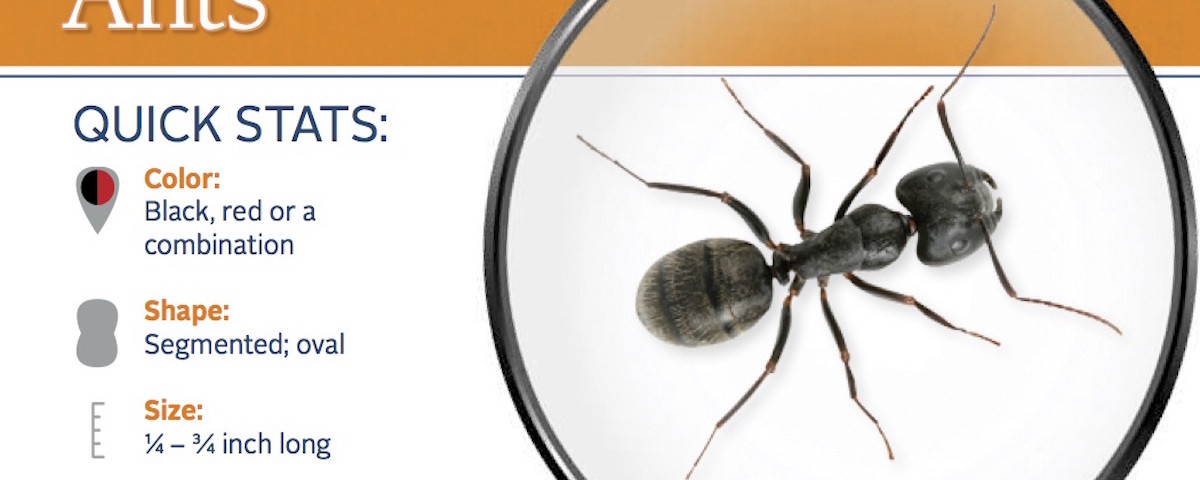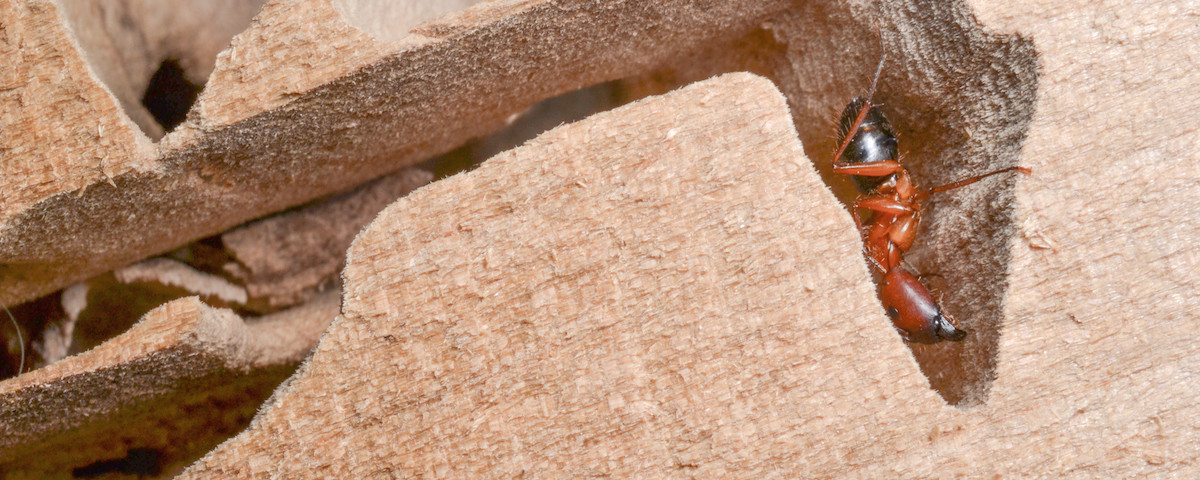Camponotus pennsylvanicus (DeGeer)
The black carpenter ant is a common invader of homes in the northeastern United States and. In their natural habitat, carpenter ants ad in the decomposition of dead, decaying trees. They normally nest in logs, stumps, and hollow trees. However, the large, dark-colored workers often invade homes in search of food. These ants seldom tunnel into dry, sound wood, but they may excavate moist, rotting wood and other soft materials (such as foamed plastic insulation board) to make satellite nests. Rarely will the expansion of a nest into a building’s wooden timbers cause structural damage. Homes built in wooded areas are especially subject to infestation.
Description
Carpenter ants and termites are social insects that live in colonies and excavate wood. Because of this, homeowners may mistake one for the other. It is important to distinguish between the two because each requires different methods of control.
Carpenter Ants
- Workers are wingless, dark shiny brown to black in color, and 1/4 to 1/2 inch in length. They may be seen crawling around inside a residence.
- Winged reproductive forms resemble workers in color and shape but are up to 3/4 inch long
- The body is constricted between the thorax and the abdomen.
- The antennae are elbowed.
- The front wing of a reproductive ant is longer than the hind wing.
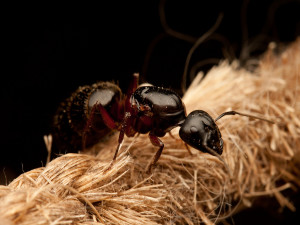
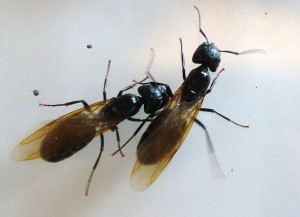
Eastern Subterranean Termites
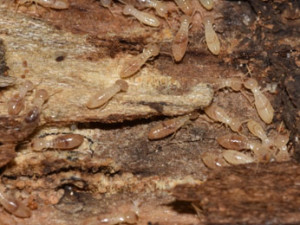
- Workers (Fig. 3) are creamy-white, wingless, and 1/8 to 1/4 inch in length. They live hidden from view, unless their tunnels are exposed.
- Reproductive forms are brown or black, have wings, and measure about 3/8 to 1/2 inch in length.
- The body is not constricted between the thorax and the abdomen.
- The antennae are straight with beadlike segments.
- The front and hind wings of a reproductive termite are about equal in length.
Life History
A carpenter ant colony has one wingless queen and many sterile, wingless, female workers. It also has white, legless larvae and, at certain times, winged females and males. The eggs are white and the pupae cocoons are tan. Usually, a colony does not produce winged males and queens (the reproductives) until it is several years old and has about 2,000 to 3,000 workers. Approximately 200 to 400 winged ants develop in the summer, remain in the nest through the winter, and leave the nest the following spring or early summer. The ants hibernate (are inactive) during the winter. They will be active, however, if a nest is located in a heated portion of a building.
Winged males and females emerge from established colonies on warm days in the spring and early summer. Mating occurs during a brief flight, after which the male dies, and the female (queen) removes her wings and searches for a suitable nesting site. The nest is usually located in a cavity in the soft, moist, decaying wood of a hollow tree, stump, or log. A new queen lays fifteen to twenty eggs, which produce the first brood of offspring. The whitish, soft-bodied, legless larvae later become the sterile female workers.
Development from egg to worker requires a minimum of about sixty days. The workers of the first brood are small because they are nourished only from food reserves that are stored in the queen’s body. Once these workers become adults, the queen’s only function is to lay eggs. The adult workers forage for food, enlarge the nest, and feed and care for the queen and subsequent larvae. They eat dead insects and other small invertebrates as well as the honeydew secreted by aphids and scale insects. They regurgitate this food and feed the larvae and the queen. Workers of succeeding broods are larger because the foraging workers feed them.
Diagnosis
The presence of large (1/2 inch), wingless, dark-colored ants inside a home is usually the first sign of an infestation. However, this does not necessarily mean that a nest is present indoors. The nest may actually be located outside, near the building. Thus, foraging workers from the nest may be entering the structure in search of food and water. These worker ants, which usually emerge at night, will feed on meats and foods containing sugar and fat. During the summer, homeowners can use a flashlight to look for foraging workers at night. Check basement, attic, garage and building exterior from May through July between the hours of 10:00 p.m. and 2:00 a.m. It may be possible to follow the ants back to their nest or discover where they are entering the house. If numerous winged reproductive ants are found at windows inside the house, they probably came from an indoor nest.
The indoor nest(s) may have originated from one or more parent colonies outside the home. The parent colony is often located in a tree, log, or waste wood within 100 yards of the house. Workers travel between the satellite and parent colonies. To eliminate the ants, the parent and the satellite nests must be found and eliminated. Common indoor nest locations include porch pillars and supporting timbers, sills, girders, joists, wall studs, window and door casings, and under insulation between ceiling joists or wall studs. Check areas where the wood may be wet or damp because of poor ventilation, a leaking roof, defective flashing, overflowing or leaking gutters and downspouts, condensation from water pipes, or leaking bathtubs, showers, and appliances. In homes, the ants typically do not excavate wood for nest construction, but make their nests in hollow areas of ceilings, walls, or floors. They will tunnel through sound structural timbers to gain access to a void on the other side, but this has little effect on the structural integrity of the timber.
Homeowners should watch for ants that are foraging indoors and try to find their nests. Look for piles of coarse, stringy wood particles, dead insect parts and other debris that are sifting from cracks in the siding, behind moldings, in the basement and attic, and under porches. Because carpenter ants do not consume the wood as food, excavated particles are dumped outside the nest. Unlike termites, the tunnels or galleries of carpenter ants are smooth-sided and contain no soil particles or fecal pellets. Satellite colonies within homes can sometimes be located by listening for a rustling sound in walls and ceilings using a stethoscope or inverted water glass to hear the ants.
Prevention
Remove stumps, logs, and waste wood within 100 yards of the building. Do not allow vegetation, especially evergreen shrubs and trees, to be in contact with the house. Store firewood away from the house and off of the ground, and bring it into the house only when needed. Keep wooden parts of the house and other structures dry by making necessary repairs to roofs, flashing, gutters, and downspouts. Replace any water-damaged, decaying wood. Usually, carpenter ants will not infest wood that is sound and has moisture content of less than 15 percent. Keep exterior wood surfaces painted and sealed. Seal holes through which pipes and wires enter the house. Use pressure-treated (CCA) wood for parts of the structure that will be in contact with the soil. Place a moisture barrier (plastic sheet) over soil in crawl spaces and under wooden porches, and provide adequate ventilation for such spaces.
Management
Homeowners that want to try their hand at controlling the ants should strive to locate and eliminate all of the ants’ nests. The parent and satellite colonies must be destroyed or the ants will reappear in a few days or weeks. Products that are not toxic to mammals are preferred for use by homeowners in and around the home. Dust formulations of diatomaceous earth, silica aerogel, or boric acid have no or low mammalian toxicity and may be blown into nests and cavities to kill the ants. The repair of structural problems and replacement of damaged wood should accompany the elimination of nests. Nests outside of the building should be eliminated by removing the infested wood or tree, or by treating it with an insecticide product labeled for such use. Unfortunately, it is unlikely that the satellite colony can be eliminated without the use of one or more of the materials applied by professional pest management companies.
The application of insecticide sprays, dusts, or baits to areas where the foraging ants may come in contact with them will give partial control and may eliminate the colony. The use of carpenter ant baits may be effective if the pest management professional is diligent in locating the ants’ trails and in reapplying baits as they become depleted. Frequently, for one reason or another, the ants will ignore the baits. One of the newer insecticides available to pest management companies is applied as an outside perimeter treatment. It is not repellent to the ants and usually only one treatment is required. Your pest management professional should have this material available.

